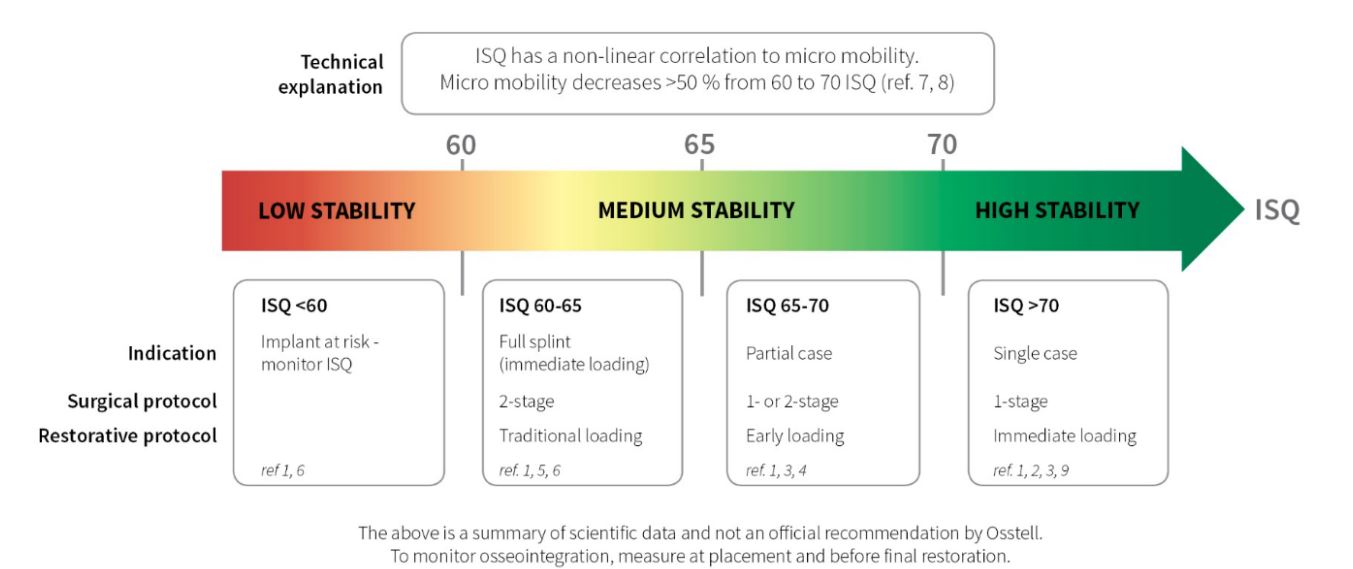
Essential in Oral Implantology: The ISQ value – by Dr Emilio Rodríguez Fernández, DDS, MS, PhD.
Dec 05, 2018
By Dr. Emilio Rodríguez Fernández. DDS, Ms, PhD
In the last two decades the use of immediate loading has become a routine procedure in implantology, with special emphasis on areas of aesthetic commitment. The healing and the loading times have been significantly reduced (1). Implant stability is one of the main factors of success in Oral implantology (2). Especially in immediate loading procedures where it is a key factor (3). The implant stability is influenced by the quantity and quality of the bone, the implant design, and surgical technique employed (4) – among other parameters.

Figure 1: Immediate implant placement in fresh extraction shocket.
Traditionally implant stability can be categorized in two terms: primary and secondary stability. Primary stability (PS) or initial stability is associated with the mechanical engagement of an implant with the surrounding bone, whereas bone regeneration and remodeling phenomena (osseointegration) determine the secondary or biological stability (BS) to the implant5. PS allows to the implant to mechanically adapt into the bone until BS is achieved.

Figure 2: Insertion torque value (45 N) achieved during the implant placement.
PS is frequently determined by using cutting-torque measurements or resonance frequency analysis (RFA)(6). Sennerby et al. introduced RFA as a quantitative method for assessing implant stability (7). The RFA is a reliable indicator for identifying implant stability with assurance (6) and the results are given as implant stability quotients (ISQ) (8).
Osstell measures the resonance frequency of a cylindrical magnetic peg (SmartPeg) screwed (4-6 Ncm) to the implant platform, which is stimulated by different frequencies. The frequencies (3000 to 8500 Hz) of the first peak are recorded along two orthogonal directions and automatically converted to ISQ scale (1 to 100 units) (9). The signals are taken without contacting the SmartPeg, through electromagnetic waves (10).

Figure 3: The ISQ scale. Source: www.osstell.com

Figure 4: Smart-peg (Type 16) screwed to the implant platform

Figure 5: The position of the ISQ probe tip should be 3-5 mm from the top of the Smartpeg, in an angle of approx 45 degrees.
In our experience, Osstell has become a useful tool in the daily practice with dental implants for several reasons:
- We can take data the same day of surgery and repeat the same process a 6-8 weeks later.
- The ISQ value achieved help to us to determinate the loading time. Especially in areas of high aesthetic commitment where the provisional restoration should be mandatory.
- The RFA measurements allow to work objectively when there is more than one clinician involved in the case. Additionally, all the implants osseointegrated showed a good ISQ value 6-8 weeks later independently of the initial torque achieved.
References
1. Hall JA, Payne AG, Purton DG, Torr B, Duncan WJ, De Silva RK. Immediately restored, single-tapered implants in the anterior maxilla: prosthodontic and aesthetic outcomes after 1 year. Clin Implant Dent Relat Res. 2007; 9:34-45.
2. Romanos GE, Nentwig GH: Immediate functional loading in the maxilla using implants with platform switching: Five-year results. Int J Oral Maxillofac Implants. 2009: 24, 1106–12
3. West JD, Oates TW. Identification of stability changes for immediately placed dental implants. Int J Oral Maxillofac Implants. 2007; 22:623-30.
4. Glauser R, Sennerby L, Meredith N, Rée A, Lundgren A, Gottlow J, Hämmerle CH. Resonance frequency analysis of implants subjected to immediate or early functional occlusal loading. Successful vs. failing implants. Clin Oral Implants Res. 2004;15:428-34.
5. Atsumi M, Park SH, Wang HL. Methods used to assess implant stability: Current status. Int J Oral Maxillofac Implants 2007;22:743-54.
6. Cehreli MC, Kökat AM, Comert A, Akkocaoğlu M, Tekdemir I, Akça K. Implant stability and bone density: assessment of correlation in fresh cadavers using conventional and osteotome implant sockets. Clin Oral Implants Res. 2009; 20:1163-9.
7. Sennerby L, Meredith N. Implant stability measurements using resonance frequency analysis: Biological and biomechanical aspects and clinical implications. Periodontol 2000 2008;47:51-66.
8. Norton MR. The Influence of Low Insertion Torque on Primary Stability, Implant Survival, and Maintenance of Marginal Bone Levels: A Closed-Cohort Prospective Study. Int J Oral Maxillofac Implants. 2017; 32:849-857.
9. Meredith N, Alleyne D, Cawley P. Quantitative determination of the stability of the implant-tissue interface using resonance frequency analysis. Clin Oral Implants Res. 1996; 7:261-7.
10. Veltri M, Balleri P, Ferrari M. Influence of transducer orientation on Osstell stability measurements of osseointegrated implants. Clin Implant Dent Relat Res. 2007; 9:60-4.
Corresponding author:
Dr. Emilio Rodríguez Fernández. DDS, Ms, PhD. mail: contacto@emilioesmidentista.com
Madrid, Spain, Europe


Add comment